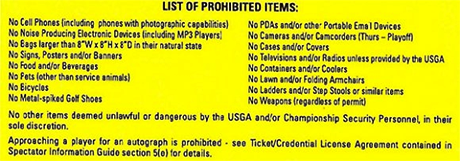Matt Kuchar misses a birdie putt today at the U.S. Open, in a photograph not taken by me
I can’t claim to be a serious golf fan–or, really, a golf fan at all–but for the past four years, I’ve been looking forward to attending this year’s U.S. Open at San Francisco‘s historic Olympic Club.
That’s because my wife Marie and I live a half-block from the venue, in a house in Westlake, the midcentury planned community in bordering Daly City. (Our neighborhood is best known as the subject of the obnoxious 1962 song “Little Boxes” by Malvina Reynolds; yes, we who live in the little boxes on the hillside made of ticky-tacky don’t take kindly to her abuse.)
When the tickets I ordered last year for today’s portion of the tournament arrived a couple of months ago, they were accompanied by a list of items which Marie and I would not be permitted to bring with us. They included…well, here’s the fine print as printed on the back of my ticket:
Ladders, weapons and coolers I could do without. Temporarily, at least. But if the restrictions on electronics didn’t exist, I’d probably have arrived with my iPhone, my iPad and a digital SLR. (iPads and other tablets weren’t explicitly banned, but they appeared to run afoul of both the “noise producing electronic device” and “portable e-mail device” clauses.)
I can’t remember the last time I willingly did without technology for any meaningful amount of time. With the exception of long airplane trips, it’s also been years since I cut myself off from Internet access. But the U.S. Golf Association had spoken: No calls, no web, no e-mail, no tweeting, no check-ins, no photographs, no anything that might interfere with game play.
Marie and I stepped out of our house this morning, and minutes later we were at the U.S. Open entrance gate, where they were using metal detectors and X-ray machines to detect any surreptitious gizmos.
We weren’t even on the course yet, and I was already seeing cool stuff I wanted to tweet about or put on Instagram. It didn’t matter how often it happened; every time, it took me a quarter-second to remember that I didn’t have my phone with me.
Coordinating our whereabouts on the course was going to be tricky, too. If Marie and I split up, we weren’t going to be able to call or text each other to determine where the other one was. Instead, we’d have to agree on a time and location to meet up–Marie, who usually uses her phone as her timepiece, was sporting a wristwatch for just this reason–and hope that neither of us got delayed or lost.
That sounded complicated, even dangerous. Although it did dawn on me that I was over thirty before I got my first cell phone, and therefore had plenty of experience arranging to meet people in this manner. Come to think of it, I was almost 42 before I used Twitter, and 46 1/2 before I used Instagram.
Eventually, Marie decided to watch hole 18 from the grandstand while I roamed around a bit. I said I’d return within twenty minutes, but had trouble wending my way back. I kept feeling my pocket for my phone so I could tell her I’d be late. Then I’d remember I couldn’t call her. Then I’d think to myself that I should call her to tell her I couldn’t call her.
Maybe the heat was getting to me; fortunately, she waited.
I kept wondering about the e-mail I wasn’t reading, and the news from the outside world I was unable to keep tabs on. I couldn’t even pull up information on the tournament. All I could do was watch the world’s greatest golfers playing on one of the world’s finest courses in gorgeous weather. It hardly seemed fair.
Any time I saw signs of connectivity, I perked up. There was a bank of Lenovo ThinkPads in the dining tent; I rushed over, but they were there to let people pull up scores. Another tent had some public phones, which sounded like a great idea until I realized you couldn’t use them to call anyone else who was at the game.
I was also jealous of attendees who seemed to be wearing some sort of earpiece, apparently provided by event sponsor American Express, even though I wasn’t sure what it was.
Despite everything, I had a great time. Watching golf, it turns out, is fun. So is doing a golf clap when you’re actually at a golf game.
Right before we left, I took a survey at a touch-screen kiosk, in part because I wondered if it would bring up the gadget policy. And it did ask me if I’d like to see a business center with e-mail access at future U.S. Opens, which I presume means that the USGA has no intention of letting spectators into future venues with unfettered access to phones, cameras and other personal electronics. I gave an enthusiastic thumbs-up to the business center, of course, even though I’m quite positive that I won’t be attending the 2013 championship at the Merion Golf Club in Ardmore, Pennsylvania.
Marie and I made our way through the cavernous Merchandise Pavilion and walked home. Back in my own living room, I picked up my iPhone, launched Foursquare and retroactively checked into the U.S. Open. It was good to be back in the real world.



